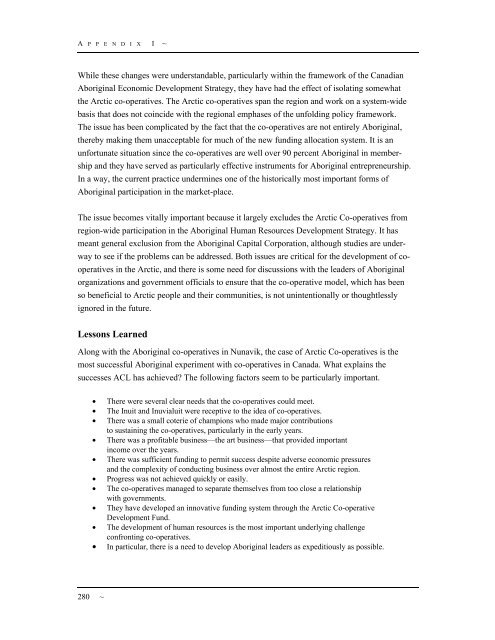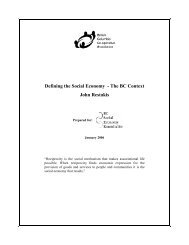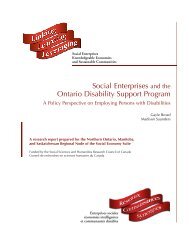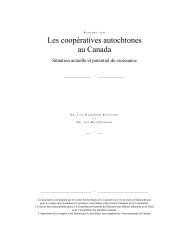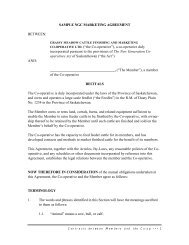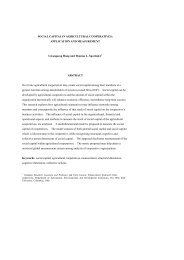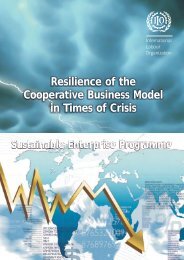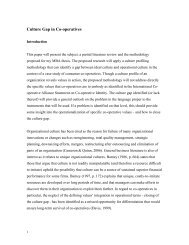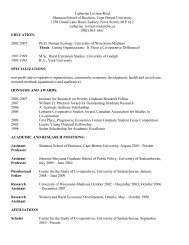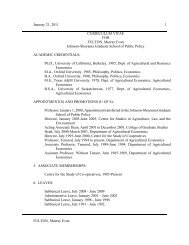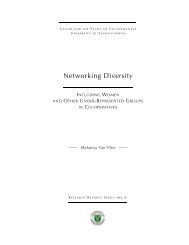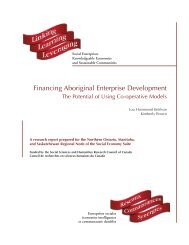Aboriginal Co-operatives in Canada - Centre for the Study of Co ...
Aboriginal Co-operatives in Canada - Centre for the Study of Co ...
Aboriginal Co-operatives in Canada - Centre for the Study of Co ...
You also want an ePaper? Increase the reach of your titles
YUMPU automatically turns print PDFs into web optimized ePapers that Google loves.
A P P E N D I X I ~While <strong>the</strong>se changes were understandable, particularly with<strong>in</strong> <strong>the</strong> framework <strong>of</strong> <strong>the</strong> Canadian<strong>Aborig<strong>in</strong>al</strong> Economic Development Strategy, <strong>the</strong>y have had <strong>the</strong> effect <strong>of</strong> isolat<strong>in</strong>g somewhat<strong>the</strong> Arctic co-<strong>operatives</strong>. The Arctic co-<strong>operatives</strong> span <strong>the</strong> region and work on a system-widebasis that does not co<strong>in</strong>cide with <strong>the</strong> regional emphases <strong>of</strong> <strong>the</strong> unfold<strong>in</strong>g policy framework.The issue has been complicated by <strong>the</strong> fact that <strong>the</strong> co-<strong>operatives</strong> are not entirely <strong>Aborig<strong>in</strong>al</strong>,<strong>the</strong>reby mak<strong>in</strong>g <strong>the</strong>m unacceptable <strong>for</strong> much <strong>of</strong> <strong>the</strong> new fund<strong>in</strong>g allocation system. It is anun<strong>for</strong>tunate situation s<strong>in</strong>ce <strong>the</strong> co-<strong>operatives</strong> are well over 90 percent <strong>Aborig<strong>in</strong>al</strong> <strong>in</strong> membershipand <strong>the</strong>y have served as particularly effective <strong>in</strong>struments <strong>for</strong> <strong>Aborig<strong>in</strong>al</strong> entrepreneurship.In a way, <strong>the</strong> current practice underm<strong>in</strong>es one <strong>of</strong> <strong>the</strong> historically most important <strong>for</strong>ms <strong>of</strong><strong>Aborig<strong>in</strong>al</strong> participation <strong>in</strong> <strong>the</strong> market-place.The issue becomes vitally important because it largely excludes <strong>the</strong> Arctic <strong>Co</strong>-<strong>operatives</strong> fromregion-wide participation <strong>in</strong> <strong>the</strong> <strong>Aborig<strong>in</strong>al</strong> Human Resources Development Strategy. It hasmeant general exclusion from <strong>the</strong> <strong>Aborig<strong>in</strong>al</strong> Capital <strong>Co</strong>rporation, although studies are underwayto see if <strong>the</strong> problems can be addressed. Both issues are critical <strong>for</strong> <strong>the</strong> development <strong>of</strong> co<strong>operatives</strong><strong>in</strong> <strong>the</strong> Arctic, and <strong>the</strong>re is some need <strong>for</strong> discussions with <strong>the</strong> leaders <strong>of</strong> <strong>Aborig<strong>in</strong>al</strong>organizations and government <strong>of</strong>ficials to ensure that <strong>the</strong> co-operative model, which has beenso beneficial to Arctic people and <strong>the</strong>ir communities, is not un<strong>in</strong>tentionally or thoughtlesslyignored <strong>in</strong> <strong>the</strong> future.Lessons LearnedAlong with <strong>the</strong> <strong>Aborig<strong>in</strong>al</strong> co-<strong>operatives</strong> <strong>in</strong> Nunavik, <strong>the</strong> case <strong>of</strong> Arctic <strong>Co</strong>-<strong>operatives</strong> is <strong>the</strong>most successful <strong>Aborig<strong>in</strong>al</strong> experiment with co-<strong>operatives</strong> <strong>in</strong> <strong>Canada</strong>. What expla<strong>in</strong>s <strong>the</strong>successes ACL has achieved? The follow<strong>in</strong>g factors seem to be particularly important.• There were several clear needs that <strong>the</strong> co-<strong>operatives</strong> could meet.• The Inuit and Inuvialuit were receptive to <strong>the</strong> idea <strong>of</strong> co-<strong>operatives</strong>.• There was a small coterie <strong>of</strong> champions who made major contributionsto susta<strong>in</strong><strong>in</strong>g <strong>the</strong> co-<strong>operatives</strong>, particularly <strong>in</strong> <strong>the</strong> early years.• There was a pr<strong>of</strong>itable bus<strong>in</strong>ess—<strong>the</strong> art bus<strong>in</strong>ess—that provided important<strong>in</strong>come over <strong>the</strong> years.• There was sufficient fund<strong>in</strong>g to permit success despite adverse economic pressuresand <strong>the</strong> complexity <strong>of</strong> conduct<strong>in</strong>g bus<strong>in</strong>ess over almost <strong>the</strong> entire Arctic region.• Progress was not achieved quickly or easily.• The co-<strong>operatives</strong> managed to separate <strong>the</strong>mselves from too close a relationshipwith governments.• They have developed an <strong>in</strong>novative fund<strong>in</strong>g system through <strong>the</strong> Arctic <strong>Co</strong>-operativeDevelopment Fund.• The development <strong>of</strong> human resources is <strong>the</strong> most important underly<strong>in</strong>g challengeconfront<strong>in</strong>g co-<strong>operatives</strong>.• In particular, <strong>the</strong>re is a need to develop <strong>Aborig<strong>in</strong>al</strong> leaders as expeditiously as possible.280 ~


